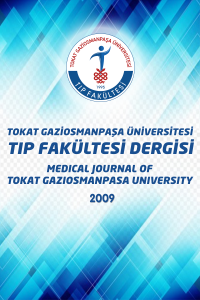Intraventriküler Basit Kistin Endoskopik Fenestrasyonu
Sıklıkla intraventriküler araknoid kistler olarak adlandırılan intraventriküler basit kistler, nadir ve genellikle asemptomatiktirler. Kist semptomatik hale gelince cerrahi müdahale gerektirir. Bu kistler geleneksel açık cerrahi, şant prosedürleri, endoskopik cerrahiler veya bunların kombinasyonları ile tedavi edilebilirler. Biz kliniğinde dirençli baş ağrısı bulunan bir hastayı takdim ettik. Hastanın manyetik rezonans görüntüleri, ventriküler kavitede genişlemeye yol açan sol lateral ventrikül trigonunda kisti gösterdi. Hastaya endoskopik cerrahi girişimi uyguladık. Giriş için temporal burr hole kullandık. Bu şekilde ventriküler ve kistik anatomiyi belirleyebilmek için yeterli endoskopik görüntü elde ettik. Kistin ventriküler kaviteye fenestrasyonunun olabildiğince geniş olmasını sağladık. Daha sonra endoskopu kist kavitesi içinde ilerleterek konturlateral kist duvarını tespit ettik. Kontur-lateral kist duvarını da fenestre ettik. Hastanın şikayeti işlem sonrası kayboldu. Intraventriküler basit kistlerin tedavisi için endoskopik cerrahi minimal invaziv oluşu ve daha az komplikasyon riski taşıyor oluşu avantajlarıyla çok etkili bir yöntemdir.
Anahtar Kelimeler:
İntraventriküler, kist, tedavi, endoskopik fenestrasyon
Endoscopic Fenestration of an Intraventricular Simple Cyst
Intraventricular simple cysts, frequently referred to as intraventricular arachnoid cysts, are rare and usually asymptomatic. Surgical intervention must be performed when a cyst becomes symptomatic. These cysts can be treated by traditional open surgeries, shunting procedures, endoscopic surgeries or combinations of these surgeries. We report a case presented with resistant headache. Her magnetic resonance imaging showed intraventricular cyst in the trigone of left lateral ventricle resulting in expansion of the ventricular cavity. We performed endoscopic procedure. We used temporal burr hole to introduce into ventricular cavity and got sufficient endoscopic view to identify normal anatomy of ventricle and cyst. We performed fenestration of the cyst into the ventricular cavity as widely as possible. Then the endoscope was introduced into the cyst cavity to find the contralateral cyst wall. Contralateral cyst wall inside the cyst cavity was also fenestrated. The patient recovered well. Endoscopic procedure is very effective with the advantage of minimal invasiveness and less complications for the treatment of intraventricular simple cysts.
Keywords:
Intraventricular, cyst, treatment, endoscopic fenestration,
- ISSN: 1309-3320
- Başlangıç: 2009
- Yayıncı: Tokat Gaziosmanpaşa Üniversitesi
Sayıdaki Diğer Makaleler
Ramazan Tetikçok, Gülseren Oktay, Nagihan Çeltek
Seronegatif Sneddon Sendromu: Olgu Sunumu
Gülay Soykök, Kadir Soykök, Mehmet Fatih Uzun
Tekrarlayan Rinorenin Nadir Bir Nedeni: Etmoidal Ensefalosel
Intraventriküler Basit Kistin Endoskopik Fenestrasyonu
Özgür Demir, Fatih Ersay Deniz, Erol Öksüz
Tek Kullanımlık Tıbbi Malzemelerin Yeniden Kullanımı: Sistematik Tarama
Orhan Balta, Murat Aşcı, Recep Kurnaz, Sezer Astan, Bora Bostan
Rezan Harman, Özgür Günal, Ayhan Gözaydın, Murat Yardımcı, Ayşe Özboz, Can Polat Eyigün
